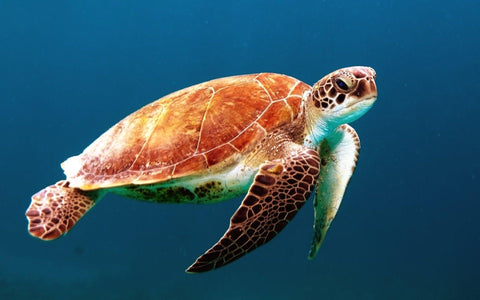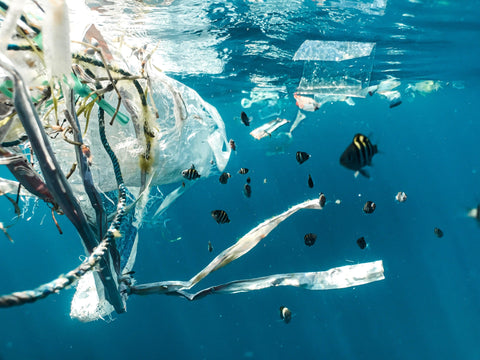
Why Do Turtles Like To Eat Plastic Straws?

The World Conservation Union classifies six of the seven sea turtle species as threatened or endangered due to human actions and lifestyles. And one of the five major hazards to sea turtles is pollution.
Plastic pollution can be a major hazard to sea turtles. In fact, for 22% of sea turtles, ingesting just one plastic item can be a death sentence. So, ingesting plastic isn’t just a harmless mistake. Consuming this man-made material can cost sea turtles their lives.
But what about plastic straws? How can they be harmful? Well, it turns out, they might be more hazardous than you think.
What Do Turtles Eat?
Contrary to what many people believe, the sea turtle diet isn’t just limited to jellyfish. Their diets are much more diverse and depend on the species of the sea turtle.
The variety of their diet actually benefits the ocean ecosystem. By consuming different species, sea turtles provide balance to the marine food web.
So, what do sea turtles like to feast on? Below is a non-exhaustive list:
- Crabs
- Mollusks
- Shrimp
- Jellyfish
- Snails
- Crustaceans
- Fish
- Squids
- Vegetation (i.e. seagrasses, seaweed, algae)
- Soft coral
- Anemones
- Sea sponges
Why Do Turtles Like to Eat Plastic Straws?

Beyond other animals, sea turtles also like to eat plastic straws. This is because they mistake them for jellyfish. According to scientists, sea turtles mistake the scent of plastic for food. In fact, in a study of 15 loggerhead turtles, researchers found that the sea creatures preferred the smell of food and ocean-soaked plastic.
This means that they often can’t tell the difference between the smell of plastic and their real food when the plastic has accumulated microbes, algae, plants, and small animals on its surface.
This “biofouled” plastic has likely sat in the ocean for a while and has taken on scents familiar to sea turtles. This makes plastic straws fair game for turtles and other animals.
How Do Plastic Straws Affect the Ocean?

Plastic isn’t biodegradable. Instead, it breaks down into tiny particles called microplastics. Even though microplastics are small, they’re difficult to filter or clean from the ocean.
Straws are among the top 10 items that surface during beach clean-ups, according to the Ocean Conservancy. This is because they’re too lightweight for easy recycling. As a result, they become trash and often end up in the ocean, polluting the water. And unfortunately, they end up killing sea animals, including turtles.
Why Are Plastic Straws Bad for Turtles?
Scientists estimate that over half of the world’s sea turtles have ingested plastic. And according to research, ingesting over 12 pieces of plastic can kill turtles. Once a turtle swallows plastic, they can’t throw it back up. So, as a result, most of the plastic they’ve ingested gets stuck in their gut, limiting the turtle’s ability to absorb and digest food.
Malnutrition
Plastic straws can pose a serious health risk because they don’t break down, which means they stay in the stomachs of sea turtles. As a result, they send messages to the brain that the stomach is full, which signals to the turtle that it doesn’t need to feed.
So what happens to a sea animal that isn’t eating? They often succumb to malnutrition or ultimately, end up starving to death. This is because one, their stomachs are full of plastic so they’re often too full to ingest food. And two, all that plastic makes it difficult to absorb nutrients from food when do they eat.
Another danger to sea turtles eating plastic straws is that they often get entangled into their nostrils. Smaller straws can do more harm than we can imagine because they’re sharp and can injure a turtle’s nose.
Floating and Buoyancy Issues
Turtles that have consumed a lot of plastic straws often end up with bloated stomachs. As a result, they float near the surface of the water, which makes them vulnerable to predators.
Ingesting excessive amounts of plastic straws can also cause buoyancy issues in sea turtles. This can hinder a turtle’s growth as they have difficulty submerging themselves in water.
That’s because they struggle to reach food. This can also negatively impact reproduction, as turtles have trouble mating when they can’t submerge themselves in the water.
Adverse Growth and Survival Rates in Hatchlings

While plastics affect sea turtles in all stages of their lives, younger turtles are more vulnerable to plastic debris. That’s because plastic straws invade the natural habitat of baby hatchlings.
These young turtles need dense seaweed mats on the ocean floor to protect them from predators. These dense seaweed mats also act as a food source.
The microplastics from plastic straws become trapped into these sheltering seaweed mats. And when hatchlings eat the microplastics, their tiny stomachs begin to fill up with the plastic.
Another risk plastic straws pose to young turtles is suffocation. That’s because hatchlings can get tangled and trapped in the microplastics when they litter the seaweed. This makes them unable to surface for air, which can eventually lead to suffocation.
How Can We Make a Difference?
The outlook on ocean plastics may seem grim, but since humans caused this problem, we have the power to reverse it and curb the climate crisis. For example, you can participate in a trash cleanup. So, look around on the internet for one in your community.
And even if you don’t live that close to the ocean, your gutters and storm drains may still lead to the ocean. So picking up plastic straws and other trash in your neighborhood can make a big difference.
You can make a change in other ways as well. For example, the next time you go to a restaurant and order a drink, skip the straw. Or better yet, go contribute to a cause bigger than you
Grab yourself one of Cape Clasp’s ocean plastic bracelets. Plus, with each of our designs, we donate 15% of our profits to the Sea Turtle Conservancy, so it’s our mission to keep sea turtles safe. But what about you? Are you ready to make a change? If so, shop our 100% recycled accessories today.


